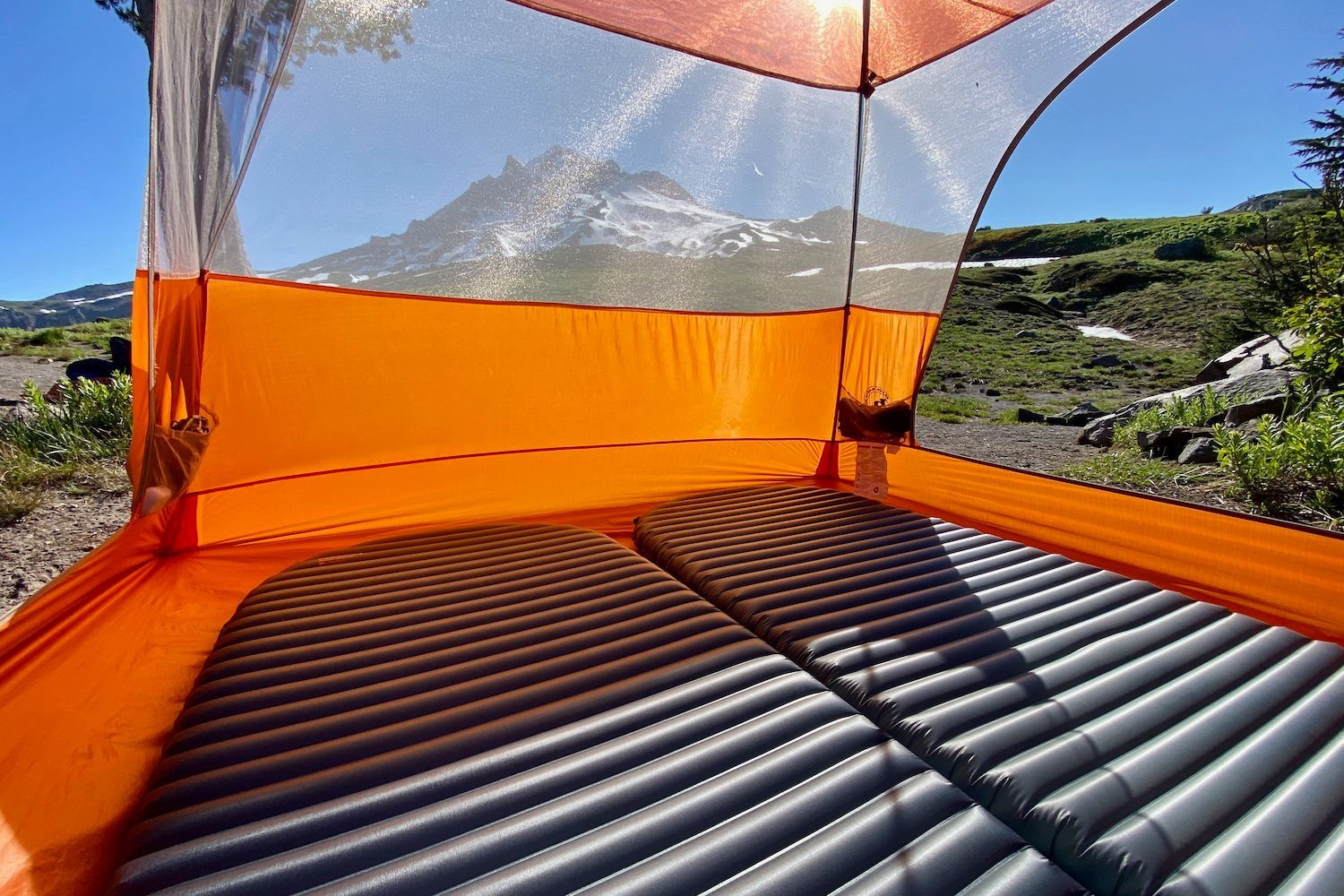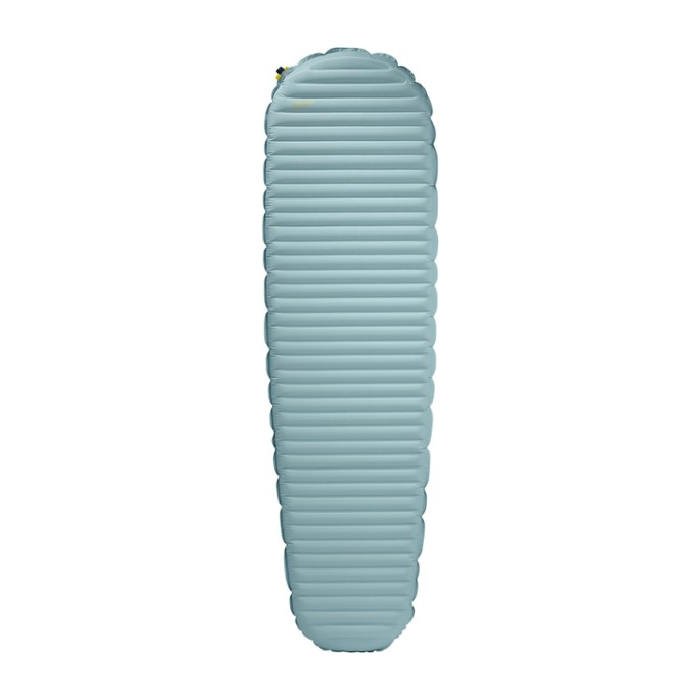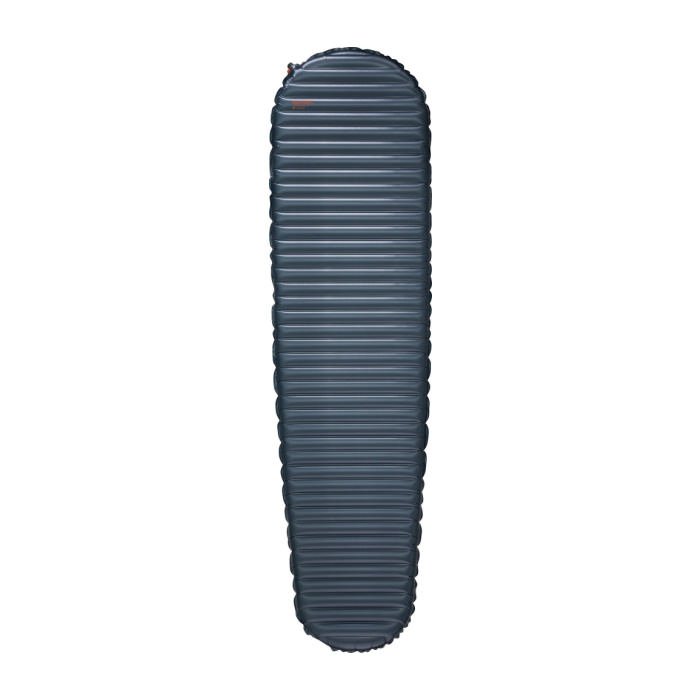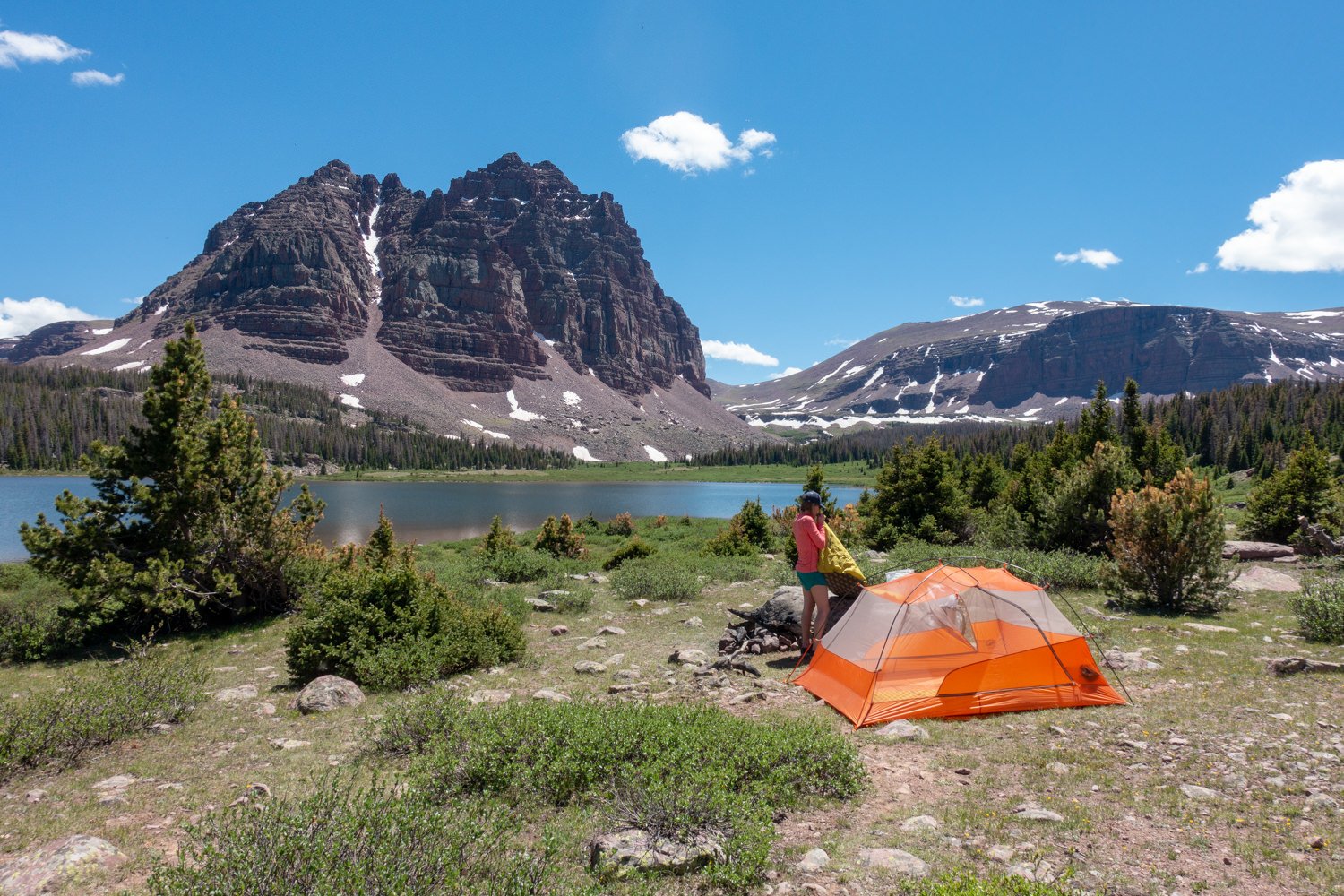
10 Best Backpacking Sleeping Pads of 2023
Great sleep in the backcountry can be surprisingly tough to come by. You’d think after a long day of hiking, most backpackers would be tired enough to pass out face-first in their rehydrated mashed potatoes. But that’s often not the case.
Packing a top-notch sleeping pad will help take your backcountry sleep to the next level. A great backpacking pad will keep you comfortable, warm, and help keep your pack weight down. Our team of gear experts has spent years testing pads on trails all over the world to bring you this list of the very best backpacking sleeping pads.
Quick Recommendations
Check out this quick list of our favorites if you’re in a hurry, or continue scrolling to see our full list with in-depth reviews.

Sleeping Pad Comparison Table

What’s Most Important to You in a Sleeping Pad?
PRICE:
You don’t have to spend a ton of money to get a good backpacking sleeping pad, but many backpackers (us included) are willing to splurge a little for a high-quality pad they plan on putting to good use. Getting great sleep in the backcountry tends to be worth it.

WEIGHT:
Your sleeping pad will be one of the four heaviest items in your pack – tent, backpack, sleeping bag, sleeping pad – so this is a great place to save weight. We consider weight one of the most important specs for backpacking gear. The lighter your backpack, the more comfortable it will be, the more miles you’ll be able to hike, and the more enjoyable your trip will be.

WARMTH:
Insulation tends to be one of the most overlooked specs of backpacking sleeping pads. The R-value of a sleeping pad measures how well it insulates you from the cold ground. The higher the R-value, the warmer the pad. Sleeping pad insulation can easily mean the difference between being toasty warm and shivering through the night. Sleeping pads with R-values of 0-3 are best for warm-weather trips. R-values of 3-5 work for most 3-season backpacking conditions. R-values of 5-6 are good in temperatures around or below freezing. A pad with a 6+ R-value (or you can add a foam pad under your air pad) is great for cold sleepers or sleeping on snow.

THICKNESS:
You’ll want a sleeping pad thick enough to adjust its firmness without bottoming out, but not so thick it feels like a pool float that takes forever to blow up. Having several inches of cushion is especially important if you tend to sleep on your side.

DURABILITY:
Even the most durable backpacking air pad can spring a leak, so it’s always important to clear your sleeping space of sharp objects and bring repair tape. That said, some pads use thicker materials, making them more abrasion resistant and less likely to puncture.

Best Backpacking Sleeping Pads of 2023

Therm-A-Rest NeoAir XLite NXT
Best backpacking sleeping pad overall
Price: MSRP: $210
Weight: 13 oz
R-Value: 4.5
Pros
- Exceptional warmth-to-weight ratio
- Compact
- Comfortable
- Pump sack included
Therm-a-Rest’s new NeoAir XLite NXT is the best all-around 3-season sleeping pad on the market, hands down. It has a rare combination of comfort, warmth, and weight that make it very tough to beat for backpacking.
The new NXT version of the XLite is 3 inches thick, so it’s a bit cushier than before, and it has a slightly higher R-value too. One of our favorite features of the XLite is just how lightweight it is while still maintaining excellent insulation and durability. Keeping pack weight down on backcountry trips is critical, and the XLite is a stand-out in this arena.
The main knock on previous XLite models has been the crinkly sound they make when shifting around. We’re happy to report that the new NXT version is much quieter. We’d say the XLite NXT is just about as quiet as most air pads, but few can compete with its other specs.
The NeoAir XLite is a truly exceptional sleeping pad that we’ve put through the wringer over thousands of miles on the trail. It’s an all-time great backpacking sleeping pad, and we think you’ll agree.
Check out our full review of the XLite NXT here.

Therm-a-Rest NeoAir XTherm NXT
Best sleeping pad for cold sleepers & chilly conditions
Price: MSRP: $240
Weight: 16 oz
R-Value: 7.3
Pros
- Exceptional warmth-to-weight ratio
- Compact for a 4-season pad
- Comfortable
- Durable
- Pump sack included
Cons
- Expensive
- Slight crinkle sound
The Therm-a-Rest NeoAir XTherm NXT is a warmer and more durable version of the XLite pad listed above. So why does it deserve a special spot on this list? It’s just that good.
Insulation (R-value) is a highly underrated characteristic in sleeping pads. If you’re a cold sleeper or you backpack in sub-freezing temps, we recommend bumping up to the XTherm. The latest NXT model is warmer, thicker, and even a touch lighter than before. With such a preposterous warmth-to-weight ratio, the XTherm is undoubtedly one of the best backpacking sleeping pads out there.
The XTherm also has a durable layer of 70-denier fabric on the underside – which we love – to combat wear and prevent punctures. This pad does make a slight crinkle sound when you shift around on it, but its considerable strengths far outweigh this minor downside.
With a weight that’s lower than the typical 3-season pad, but an R-value ready for serious winter adventures, it’s no wonder why the NeoAir XTherm has been a fan favorite for many years.
Check out our full review of the XTherm NXT here.

Therm-a-Rest NeoAir UberLite
Best ultralight sleeping pad for summer backpacking
Price: MSRP: $230
Weight: 8.8 oz.
R-Value: 2.3
Pros
- Ultralight
- Compact
- Comfortable
- Pump sack included
Cons
- Expensive
- Not warm enough for sub-freezing temps
- Less durable than some
The Therm-a-Rest NeoAir UberLite is often the sleeping pad you’ll find in our packs on summer backpacking trips. It’s very comfortable, has a tiny packed size, and best of all – it’s ridiculously lightweight. This helps us keep our pack weight to an absolute minimum on burly, high-mileage adventures.
Like most ultralight gear, the UberLite is made with thin materials, so you’ll want to be careful with it to avoid punctures. We clear sharp rocks and pokey sticks from under our tents, and we always carry repair tape just in case. Using this small amount of care, we’ve had great results keeping the UberLite fully inflated and super comfy.
Though it requires a little more diligence, the UberLite is a truly exceptional ultralight backpacking sleeping pad for those looking to keep pack weight to a minimum.
Check out our full review of the UberLite here.

NEMO Switchback
Best foam sleeping pad
Price: MSRP: $55
Weight: 14.5 oz.
R-Value: 2
Pros
- More durable than air pads
- Affordable
- Quick to pack/unpack
- Doubles as a sit pad
Cons
- Not as comfortable as air pads
- Bulky
- Not warm enough for sub-freezing temps
Tired of worrying about your air pad staying inflated? Look no further than the affordable and hassle-free NEMO Switchback. This closed-cell foam pad is easy on the wallet and it’s also one of the lightest sleeping pads on our list.
Foam pads are nice because you’ll never have to spend time inflating/deflating them, and you’ll never have to worry about waking up on the cold ground since they can’t spring a leak.
The downside with foam pads like the Switchback is they tend to be less comfortable than air pads, unless you prefer sleeping on firm surfaces. For this reason, we tend to choose air pads for most of our backcountry trips – we try to be careful with them, and we always bring repair tape just in case.
Still, there’s a lot to love about the convenience, affordability, and durability of the Switchback. So if you prefer a firm sleeping surface, simplicity, and worry-free comfort, the NEMO Switchback might be exactly what you’re looking for.
Check out our full review of the Switchback here.

Big Agnes Zoom UL
Best value ultralight sleeping pad
Price: MSRP: $180
Weight: 14 oz.
R-Value: 4.3
Pros
- Ultralight
- Comfortable (3.25 in. thick)
- Excellent value
- Compact
- Side rails keep you centered on pad
- Pump sack included
Cons
- Slow deflation
- Pump sack design isn’t the best
Big Agnes is known as the mother of comfort, and they’re definitely earning that title with the Zoom UL. Added comfort can often mean added bulk and weight when it comes to backpacking gear, but the Zoom UL delivers an exceptionally cushy night’s sleep in a small, lightweight package.
Pads with comparable weight, R-value (warmth), and packability will generally run you $200 or more, but the Zoom UL comes in at a friendlier price point. At 3.25 inches thick in the center (and 3.5 inches on the side rails to help keep you in the middle), this is also one of the thicker pads on our list. This is a real advantage for side-sleepers and those who like a squishy pad, since you’ll have more room to adjust the firmness without bottoming out.
So with all that said, why isn’t this pad at the very top of our list? It really boils down to convenience. The valve is a bit slower and more finicky to deflate, and the pump sack is our least favorite out of all the ones we tested. These aren’t the biggest gripes in the world, but when it comes to the best of the best we had to be picky.
Still, the Zoom UL is an awesome value pad that will have you sleeping like a baby in the backcountry. So if you prioritize saving money over having a few extra conveniences, you won’t be disappointed by the Zoom UL. Learn more in our full review of the Zoom UL here.

Klymit Static V
Best budget backpacking air pad
Price: MSRP: $65
Weight: 18.7 oz.
R-Value: 1.3
Pros
- Affordable
- Slightly wider & more durable than some
Cons
- Not as warm as some
- Can bottom out when shifting around
- Slow deflation
- Heavier & bulkier than some
The Klymit Static V is one of the best budget air pads on the market. It’s built with thicker materials than most lightweight backpacking sleeping pads and is slightly wider than the standard pad size as well.
The V-shaped air tubes on the Static V are quite comfortable, but the large spaces between air chambers mean you may bottom out while shifting around. The two biggest downsides of this pad are its low R-value – this pad is best for summer trips – and its basic valve. Klymit does offer an insulated version of the Static V, but it weighs quite a bit more, and its true R-value (ASTM) is only increased to 1.9.
Drawbacks aside, the Klymit Static V is still a great choice for budget-conscious backpackers. It’s durable, comfortable, and it’ll get the job done at a fraction of the price.

NEMO Tensor Insulated
Cushy, rectangular sleeping pad with quick deflation
Price: MSRP: $200
Weight: 15 oz.
R-Value: 4.2
Pros
- Quiet
- comfortable
- warm
- many size/shape options
- quick inflation/deflation
- pump sack included
Cons
- Expensive
- less durable than some
The NEMO Tensor Insulated sleeping pad is thick, comfortable, and quieter than almost any air pad we’ve tested. So if you’re looking to avoid the crinkle sound some pads have, the Tensor is an excellent option.
Another thing that sets the Tensor apart is the wide variety of shape and size options, including mummy, rectangular, and the elusive regular/wide model. The rectangular models are popular, as they allow your feet to rest wider apart when back sleeping. This, along with 3 in. of thickness, makes the Tensor a real stand-out when it comes to comfort.
The Tensor also comes with one of the best pump sacks on the market, making inflation fast and easy. On top of that, the zero-profile valve allows for quick deflation and simple micro-adjustments.
We’ve been big fans of the NEMO Tensor since the first model hit the shelves, and we still rock it for trips where extra comfort is a top priority.

REI Helix Insulated Air
Affordable & warm 3-season sleeping pad
Price: MSRP: $159
Weight: 1 lb. 5 oz.
R-Value: 4.9
Pros
- Warm
- Affordable
- Comfortable
- Quick inflation/deflation
Cons
- Can bottom out when shifting around
- Heavier/bulkier than some
REI’s Helix Insulated Air features the highest R-value of any pad in its price range, so it’s an excellent value for cold sleepers on a tight budget.
At 3 inches thick, the Helix is very cushy and comfortable. But side-sleepers and those that shift around a lot might experience some bottoming out due to its dimpled design. Hikers who lie on their back probably won’t have an issue with this, though, and will likely find the air cells to be perfectly plush.
The biggest downside of the Helix is that it’s one of the heaviest sleeping pads on our list, but it’s also one of the warmest. We always recommend keeping pack weight to a minimum to increase overall comfort on trail, but the Helix has a very fair price tag and is insulated enough for cold sleepers to stay comfortable.

Sea to Summit Ether Light XT
Thick, comfortable & durable sleeping pad
Price: MSRP: $199
Weight: 1 lb. 1.3 oz.
R-Value: 3.2
Pros
- Lightweight
- Comfortable
- Durable
- Cushy (4 in. thick)
- Quick inflation/deflation
- Pump sack included
Cons
- Expensive
- Heavier/bulkier than some
- Slightly rubbery feel/sound
Sea to Summit makes some of the most comfortable sleeping pads on the market, and the Ether Light XT Insulated (view women’s here) is one of their lightest and cushiest sleeping pads yet. The unique “air sprung cells” mimic the support of the mattresses we use at home, and they cradle the body in a way standard air pad baffles can’t.
The Either Light is also 4 inches thick, which will help you dial in your preferred firmness and ensure you never bottom out. In addition, the slightly wider side rails on the Either Light help to keep you centered on the pad throughout the night. The “Pillowlock system” on this pad is also a nice touch. It’s designed to keep your S2S Aeros pillow in place throughout the night.
With an R-value of 3.2 and a durable build, the Sea to Summit Ether Light is a great fit for 3-season backpackers looking for top-tier comfort.
Check out our full review of the Ether Light here.

Sea to Summit Ultralight Insulated
Best value sleeping pad for back sleepers
Price: MSRP: $159
Weight: 16.9 oz.
R-Value: 3.1
Pros
- Lightweight
- comfortable
- affordable
- durable
- quick inflation/deflation
- pump sack included
Cons
- Can bottom out when shifting around
- slightly rubbery feel/sound, heavier than some
Much like the Ether Lite XT listed above, Sea to Summit’s Ultralight Insulated pad (view women’s here) is one of the most comfortable backpacking pads we’ve tested. Its “air sprung cells” provide cushy comfort that feels surprisingly like your mattress at home.
The benefit the Ultralight has over the Ether Lite mostly comes in its more affordable price tag. The Ultralight is also just about as warm and comfortable as the Ether Lite, but it’s slightly less bulky. At 2 inches thick, some users might bottom out when shifting around on this pad, and the Ultralight might not be the best fit for side sleepers. That said, the Ultralight still provides a very comfortable night’s rest.
The Ultralight has a good valve system and is more durable than the average air pad as well. So if you’re in the market for a comfortable, lightweight, and durable backpacking sleeping pad that costs less than most of its competitors, the Sea to Summit Ultralight is a great choice.

Big Agnes Rapide SL Insulated
Cushy sleeping pad with side rails
Price: MSRP: $150
Weight: 1 lb. 3 oz.
R-Value: 4.2
Pros
- Comfortable (3.5 in. thick)
- Affordable
- Durable
- Side rails keep you centered on pad
- Pump sack included
Cons
- Heavier/bulkier than some
The Big Agnes Rapide SL Insulated is a super cushy, durable, and warm sleeping pad for 3-season adventures. Where the Rapide differentiates itself from other pads is its large side rails that help to keep you centered on the pad throughout the night.
The Rapide is also 3.5 inches thick, making it one of the thickest backpacking pads on the market. This will allow you to dial in the perfect firmness level to suit your sleeping style. At 19 ounces, the Rapide is among the heavier sleeping pads on our list, but its unique comfort and affordable price point still make it a great choice for many backpackers.
For those who prioritize comfort over all else, the Big Agnes Rapide SL is a top contender.

Honorable Mentions
The following backpacking sleeping pads didn’t make our final list, but they’ve still got a lot of good things going for them. You never know, one of these pads might be perfect for you:

Critical Sleeping Pad Considerations

PUMP SACKS
Pump sacks make it much easier to inflate an air pad. Most pump sacks can double as a stuff sack, and some of them can be used as a dry bag as well. Pump sacks are also good for keeping moisture from your breath out of your sleeping pad. This is especially important in cold weather when moisture can create cold spots in your pad. If internal condensation builds up too much, it can also cause mold and mildew to form and degrade the insulation over time.
AIR PADS vs FOAM PADS
The two main types of backpacking sleeping pads are air pads and foam pads. Foam pads are bulkier, but they’re more affordable, quicker to set up, and can be used for multiple purposes – like extra support for a frameless backpack or a seat around camp. Air pads are more expensive, but most backpackers find them to be much more comfortable than foam pads. The main downside with air pads is that they can puncture in the field, so you’ll always want to bring a repair kit.
REPAIR KIT
If you decide to take an air pad into the wilderness, make sure to pack a small repair kit. Sharp objects (rocks, sticks, cacti, etc.) can puncture air pads, so always check your sleeping area before setting up camp. If your pad springs a leak and you don’t have a way to fix it, you’re going to be one unhappy camper. Almost all the air pads listed above come with a repair kit, but we always pack Tenacious Tape just in case.
LENGTH
Your hips and shoulders are the biggest pressure points for sleeping pads, so it’s important to use a pad that will give you comfort in those areas. Some ultralight backpackers use short, torso-length pads and let their legs hang off the end to save weight. But this puts your body into questionable alignment unless you have adequate gear to prop up your knees and feet. Most backpackers prefer the comfort of a full-length pad that cushions their entire body and keeps their feet warm.

WIDTH
Choosing the right width for your sleeping pad will largely depend on your sleeping style. Side sleepers are often fine with standard width pads, and back sleepers tend to prefer a bit more width to keep their arms from sliding off. Almost all the pads we list above come in a wide size option.
SHAPE
Many backpackers choose mummy-shaped sleeping pads to save weight, but those who like to sprawl out while sleeping will probably get more enjoyment out of a rectangular pad.
Having a highly packable backpacking sleeping pad is a nice benefit, and most air pads pack down very small these days.
If you choose a bulky sleeping pad, you may have to strap it to the outside of your bag. That’s not a big deal for foam pad users, but leaving an air pad exposed to punctures on the outside of your pack is a recipe for disaster.
BUYING ONLINE
Check the seller’s return policy, but you can almost always return an unused sleeping pad within a certain time frame after purchasing. We recommend buying your top choice, testing it at home, and returning/exchanging if it doesn’t feel quite right. We’ve been buying lightweight sleeping pads online for years, and we’ve yet to have any problems.

More Information
We hope this guide helps you find the perfect gear for your needs. If you have more questions or a suggestion, we’d love to hear from you! Sign up for our newsletter to stay updated on our latest posts then visit our Facebook page and Instagram to join the community conversation. If you found this guide helpful, please give it a share on social media! Also, be sure to check out our CleverHiker Gear Guide to see all of our top gear picks. Thanks for reading and happy trails!







